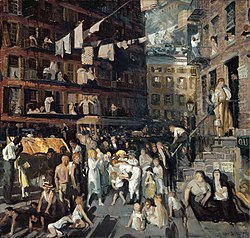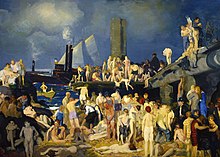乔治.贝洛斯Bellows, George
乔治.贝洛斯Bellows, George(1882年8月12日—1925年1月8日)贝洛斯对摆姿势的肖像和理想的田园风光不以为然。他认为艺术应该反映真实,特别是城市万象的揭露。作品有热闹喧嚣的一面,也有阴暗险恶的一面,多角度再现都市生活的复杂性。
晚年,他的创作热情不减,尝试了很多不同的主题和技法。无论是绘画还是生活,贝洛斯都使人感到一种美国式的热情,进取的精神。
青年
乔治·韦斯利波纹管出生和长大俄亥俄州哥伦布市,他是唯一的孩子乔治波纹管和安娜Wilhelmina史密斯风箱(他有一个同父异母的姐姐劳拉18年他的高级)。他出生他的父母结婚四年后,在五十岁(乔治)和40(安娜)。他的母亲是一个捕鲸船长的女儿Sag Harbor,长岛在那里,和他的家人返回他们的暑假。他开始绘图之前幼儿园,小学老师经常问他在感恩节和圣诞节装饰他们的教室黑板。
10岁的乔治决定成为一名运动员,并训练自己成为一个受欢迎的棒球和篮球运动员。他变得足够好多年之后这两个项目玩半职业性的球。大四期间,棒球球探从印第安纳波利斯团队做了一项提议。他拒绝了,选择录取美国俄亥俄州立大学(1901 - 1904)。他玩棒球和篮球团队,并提供Makio插图,学校的学生年鉴。鼓励他成为一名职业篮球运动员,作为商业插画家和他工作在一个学生并继续接受杂志作业终其一生。尽管有这些机会在体育和商业艺术,波纹管所需的成为一个成功的画家。他于1904年离开俄亥俄州立大学之前,搬到毕业纽约学习艺术。
波纹管很快的学生罗伯特·亨利。之前,later-famous著名艺术家建立了自己的学校,当时是谁教的纽约艺术学院。学习时,波纹管成为与亨利的“八”和垃圾箱画派,一群艺术家主张绘画一切形式的当代美国社会。到1906年,波纹管和其他艺术学生爱德华Keefe成立一个工作室在1947年百老汇街.
纽约
悬崖峭壁,(1913),洛杉矶县艺术博物馆
波纹管在1908年首次实现了广泛的注意,当他和亨利的其他学生组织了一次展览的主要城市研究。虽然许多评论家认为这是粗略的画,别人发现他们欢迎大胆,超出了他的老师的工作。波纹管任教纽约艺术学生联盟1909年,虽然他更感兴趣的职业生涯作为一个画家。名声大振,他导致了其他国家认可的评判。
波纹管的城市纽约场景描绘了粗糙和混乱的工薪阶层的人,社区,和讽刺上层阶级。从1907年到1915年,他执行的一系列绘画描绘纽约降雪。在这些画风箱发达他强烈的光线和视觉质感,蓝色和白色之间的表现形成了鲜明的对比是一望无际的冰雪和城市结构的粗糙和肮脏的表面,并创建一个审美的讽刺形象同样粗糙和肮脏的男人在努力清除纯粹的讨厌雪。然而,波纹管的一系列绘画描绘业余拳击比赛,可以说是他的签名对艺术史的贡献。他们被黑暗包围的特点,通过明亮的,大约躺人物生动的笔触罢工与强烈的运动和方向。
社会和政治的主题
一个1920的肖像画Waldo皮尔斯乔治风箱,展出de Young博物馆在旧金山
使人和睦的人有福了(1917),群众
越来越多的声望作为一个画家他的生活和工作带来了变化。虽然他早些时候继续他的主题,波纹管也开始收到佣金画像,以及社会的邀请,来自纽约的富豪精英。外,他跟随亨利,开始夏天在缅因州,画海景Monhegan和Matinicus岛屿。
社会意识的同时,总是波纹管也与一群激进的艺术家和活动家名为“抒情的离开”,他们往往对无政府主义在他们极端的倡导个人权利。他教第一现代的学校在纽约(他的导师一样,亨利),然后用的编辑委员会社会主义日报》群众,他贡献了很多图纸和1911年开始打印。然而,他经常与其他贡献者是因为他相信艺术自由应该胜过任何意识形态的编辑政策。波纹管也从这个圆特别是反对在他的公众支持美国介入第一次世界大战。1918年,他创建了一个系列的石版画和绘画,生动地描绘了盟友说已经犯下的暴行德国在其入侵比利时。其中值得注意的是德国人到达,可怕了一名德国士兵抑制比利时少年的手刚刚被切断了。然而,他的作品也严厉批评了国内反战的审查和迫害反对者由美国政府下间谍法案.
他还批评的自由在战争捕获的场景了。这位艺术家约瑟夫Pennell认为,由于波纹管没有亲眼目睹了他画的事件,他无权油漆。波纹管回答说,他并没有意识到列奥纳多·达·芬奇“有票油漆最后的晚餐"
以后的生活
1915年河前1日
邓普西和Firpo(1924),惠特尼美国艺术博物馆
波纹管的后油更侧重于家庭生活,与妻子和女儿钟爱的主题,绘画也日益显示编程和理论方法,颜色和设计,标志着流体强壮从早期的工作。
除了绘画之外,波纹管为光刻技术做出了重要的贡献,帮助扩大使用媒介的艺术在美国他安装了一个光刻机在1916年他的工作室,和1921年至1924年,他与主打印机博尔顿布朗一百多个图像。波纹管也说明了很多书在他后来的职业生涯中,包括一些h·g·威尔斯.
波纹管任教芝加哥艺术学院在1919年。1920年,他开始每年花费近一半的伍德斯托克,纽约为他的家人,他建了一个家。[16]他死于1925年1月8日,在纽约市,腹膜炎失败后,往往会破裂附录.他离开了他的妻子,艾玛的故事波纹管(1910)结婚,和女儿安妮和琼。波纹管是埋在生材公墓在布鲁克林。
绘画和版画由乔治·波纹管在许多主要的美国艺术博物馆的收藏,其中包括国家美术馆的艺术在华盛顿特区,纪念美术馆罗彻斯特大学的罗切斯特,纽约,惠特尼和现代艺术博物馆在纽约,海德集合,在格伦斯福尔斯,纽约。的哥伦布艺术博物馆波纹管的家乡也有一个相当大的收集他的画像和纽约街景。的白宫在1919年收购了他1919年的绘画三个孩子,现在显示在绿色的房间.
惠特尼美国艺术博物馆出版的传记风箱的艺术家乔治·威廉·艾格斯是美国艺术家系列的一部分。在1992年它安装一个广泛的艺术展览(展览是一个合资公司与洛杉矶县艺术博物馆)。
档案和特殊的集合阿默斯特学院他的论文。
死后的销售和展览
男人的码头,1912年
1999年12月,马球人群,1910年绘画,卖了美元2750万年到亿万富翁比尔盖茨.2008年11月,波纹管的码头,1912幅布鲁克林码头生成的东河和描述曼哈顿地平线的背景,是被拍卖佳士得在纽约。它将设置一个美国绘画拍卖的记录25 - 35百万美元的估计。这幅画的出售是一个来源的争议在伦道夫学院,因为它是第一个购买的杰作迈尔艺术博物馆由学生和当地居民在2500年筹集了2500美元购买它。由于艺术市场的一系列诉讼和灰心丧气,这幅画仍未售出直到2014年它成为第一个美国主要绘画被英国购买国家美术馆在伦敦。
2001年,托马斯。法国艺术成为乔治风箱家族信托的独家代理。
伦道夫大学问了国家美术馆的艺术在华盛顿特区,借“码头”的人,包含在2012年的展览。一个主要的波纹管回顾举行皇家艺术学院在2013年的伦敦。“码头”的男人现在国家美术馆在伦敦。
Youth
George Wesley Bellows was born and raised in Columbus, Ohio.He was the only child of George Bellows and Anna Wilhelmina Smith Bellows (he had a half-sister, Laura, 18 years his senior). He was born four years after his parents married, at the ages of fifty (George) and forty (Anna).[9] His mother was the daughter of a whaling captain based in Sag Harbor, Long Island, and his family returned there for their summer vacations.He began drawing well before kindergarten, and his elementary–school teachers often asked him to decorate their classroom blackboards at Thanksgiving and Christmas.
At age 10 George decided to become an athlete, and trained himself to become a popular baseball and basketball player. He became good enough at both sports to play semipro ball for years afterward. During his senior year, a baseball scout from the Indianapolis team made him an offer. He declined, opting to enroll at The Ohio State University (1901–1904). There he played for the baseball and basketball teams, and provided illustrations for the Makio, the school's student yearbook. He was encouraged to become a professional baseball player, and he worked as a commercial illustrator while a student and continued to accept magazine assignments throughout his life. Despite these opportunities in athletics and commercial art, Bellows desired success as a painter.[12] He left Ohio State in 1904 just before he was to graduate and moved to New York City to study art.[11]
Bellows was soon a student of Robert Henri, before the later-famous artist had set up his own famous school, who at the time was teaching at the New York School of Art. While studying there, Bellows became associated with Henri's "The Eight" and the Ashcan School, a group of artists who advocated painting contemporary American society in all its forms.[11] By 1906, Bellows and fellow art student Edward Keefe had set up a studio at 1947 Broadway Street.
New York
Bellows first achieved widespread notice in 1908, when he and other pupils of Henri organized an exhibition of mostly urban studies. While many critics considered these to be crudely painted, others found them welcomely audacious, a step beyond the work of his teacher. Bellows taught at the Art Students League of New York in 1909, although he was more interested in pursuing a career as a painter. His fame grew as he contributed to other nationally recognized juried shows.
Bellows' urban New York scenes depicted the crudity and chaos of working-class people and neighborhoods, and satirized the upper classes. From 1907 through 1915, he executed a series of paintings depicting New York City under snowfall. In these paintings Bellows developed his strong sense of light and visual texture,[14]exhibiting a stark contrast between the blue and white expanses of snow and the rough and grimy surfaces of city structures, and creating an aesthetically ironic image of the equally rough and grimy men struggling to clear away the nuisance of the pure snow. However, Bellows' series of paintings portraying amateur boxing matches were arguably his signature contribution to art history.[11] They are characterized by dark atmospheres, through which the bright, roughly lain brushstrokes of the human figures vividly strike with a strong sense of motion and direction.
Social and political themes
Growing prestige as a painter brought changes in his life and work. Though he continued his earlier themes, Bellows also began to receive portrait commissions, as well as social invitations, from New York's wealthy elite. Additionally, he followed Henri's lead and began to summer in Maine, painting seascapes on Monhegan and Matinicusislands.
At the same time, the always socially conscious Bellows also associated with a group of radical artists and activists called "the Lyrical Left", who tended towards anarchismin their extreme advocacy of individual rights. He taught at the first Modern School in New York City (as did his mentor, Henri), and served on the editorial board of thesocialist journal, The Masses, to which he contributed many drawings and prints beginning in 1911. However, he was often at odds with other contributors due to his belief that artistic freedom should trump any ideological editorial policy. Bellows also notably dissented from this circle in his very public support of U.S. intervention in World War I. In 1918, he created a series of lithographs and paintings that graphically depicted atrocities which the Allies said had been committed by Germanyduring its invasion of Belgium. Notable among these was The Germans Arrive, which gruesomely illustrated a German soldier restraining a Belgian teen whose hands had just been severed. However, his work was also highly critical of the domestic censorship and persecution of antiwar dissenters conducted by the U.S. government under the Espionage Act.
He was also criticized for some of the liberties he took in capturing scenes of war. The artist Joseph Pennell argued that because Bellows had not witnessed the events he painted firsthand, he had no right to paint them. Bellows responded that he had not been aware that Leonardo da Vinci "had a ticket to paint the Last Supper".
Later life
As Bellows' later oils focused more on domestic life, with his wife and daughters as beloved subjects, the paintings also displayed an increasingly programmatic and theoretical approach to color and design, a marked departure from the fluid muscularity of the early work.
In addition to painting, Bellows made significant contributions to lithography, helping to expand the use of the medium as a fine art in the U.S. He installed a lithography press in his studio in 1916, and between 1921 and 1924 he collaborated with master printer Bolton Brown on more than a hundred images. Bellows also illustrated numerous books in his later career, including several by H.G. Wells.
Bellows taught at the Art Institute of Chicago in 1919. In 1920, he began to spend nearly half of each year in Woodstock, New York, where he built a home for his family.[16] He died on January 8, 1925 in New York City, of peritonitis, after failing to tend to a ruptured appendix. He was survived by his wife, Emma Story Bellows (married 1910), and daughters Anne and Jean. Bellows is buried at Green-Wood Cemeteryin Brooklyn.
Paintings and prints by George Bellows are in the collections of many major American art museums, including the National Gallery of Art in Washington, DC, the Memorial Art Gallery of the University of Rochester, Rochester, New York, and the Whitney and theMuseum of Modern Art in New York, and The Hyde Collection, in Glens Falls, New York. The Columbus Museum of Art in Bellows' hometown also has a sizeable collection of both his portraits and New York street scenes. The White House acquired his 1919 paintingThree Children in 2007, and it is now displayed in the Green Room.
The Whitney Museum of American Art published a biography of Bellows by fellow artist George William Eggers as part of the American Artists Series. In 1992 it mounted an extensive exhibition of his art (the exhibition was a joint venture with the Los Angeles County Museum of Art).
The Archives and Special Collections at Amherst College holds his papers.
Posthumous sales and exhibitions
In December 1999, Polo Crowd, a 1910 painting, sold for U.S.$27.5 million to billionaire Bill Gates. In November 2008, Bellows' Men of the Docks, a 1912 painting of the Brooklyn docks spanning the East River and depicting the Manhattanskyline in the background, was to be auctioned at Christie's in New York. It was expected to set the record for an American painting sold at auction with an estimate of $25–35 million.[19] The painting's sale however was a source of controversy at Randolph College because it was the first masterpiece purchased for the Maier Museum of Art by students and locals who raised $2,500 to purchase it in 1920. Due to a series of lawsuits and the deflated art market, the painting remained unsold until 2014 when it became the first major American painting to be purchased by the BritishNational Gallery in London.
In 2001, Thomas French Fine Art became the exclusive agent of the George Bellows Family Trust.
Randolph College was asked by the National Gallery of Art in Washington, D.C., to lend "Men of the Docks", for inclusion in a 2012 exhibition. A major Bellows retrospective was held at the Royal Academy in London in 2013. "Men of the Docks" is now in the National Gallery in London.
艺术官网信息声明
1、本站美术网信息均来自于美术家自己或其朋友、网络等方式,本站无法确定每条信息或事件的真伪,仅做浏览者参考。
2、只要用户使用本站则意味着该用户以同意《本站注册及使用协议》,否则请勿使用本站任何服务。
3、信息删除不收任何费用,VIP会员修改信息终身免费(VIP会员点此了解)。
4、未经本站书面同意,请勿转载本站信息,谢谢配合!
- 阿尔贝托·瓦尔加斯Alberto Vargas
- 尼古拉·费申
- 惠斯勒
- 波洛克 Pollock Jackson
- 莱斯利John Leslie Breck
- 约翰·詹姆斯·奥杜邦John James Audubon
- 列维威尔斯普伦蒂斯Levi Wells Prentice
- 奥格登明顿普莱斯纳 Ogden Pleissner
- 保罗·阿克曼Paul Ackerman
- 帕特里夏Patricia Watwood
- 纳尔逊.尚克斯Nelson Shanks
- 理查德·米勒Richard E. Miller
- 马克斯菲尔德.帕里什Maxfield Parrish
- 莫里斯·普伦德加斯特Maurice Prendergast
- 玛丽·卡萨特Mary Cassatt
- 马斯登.哈特利Marsden Hartley
- 基思.帕金森Keith Parkinson
- 约瑟夫· 德坎普Joseph DeCamp
- 约瑟夫·克里斯蒂安Joseph Christian
- 约瑟夫·阿尔伯斯Josef Albers
- 约翰·亚历山大·怀特John White Alexander
- 约翰.范德林John Vanderlyn
- 约翰·亨利·特瓦克特曼John Henry Twachtman
- 萨金特(John singer sargent)











